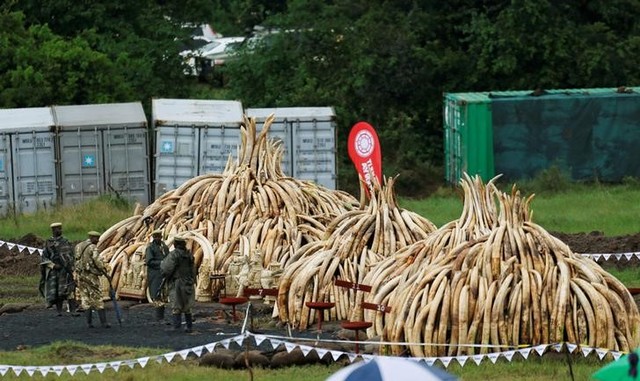African countries deeply divided over ivory trade before U.N. meeting

By Reuters
Member states of the U.N. Convention on International Trade in Endangered Species (CITES) are not meeting until September, but some African countries have already drawn their battle lines on divisive issues such as the ivory trade.
Proposals for the meeting in Johannesburg were made public this week, pitting bids by Namibia and Zimbabwe to open up the trade in elephant ivory, against initiatives led by Kenya for a complete global ban on the coveted commodity.
Those seeking to open up the trade of wild animal products argue it will raise badly-needed funds for conservation, but others say it would provide cover to poachers and make products that can endanger species socially acceptable to consumers.
“In all of these issues we have two competing views. They are all aiming for the same objective which is ensuring the survival of species in the wild,” CITES Secretary-General John Scanlon told Reuters.
Global trade of ivory is banned though CITES has allowed one-off sales of national stockpiles. Several countries also allow domestic trade.
Kenya, long at the forefront of efforts to shut the ivory trade down completely, last week torched thousands of elephant tusks and rhino horns.
But the African kingdom of Swaziland wants to sell rhino horn to pay for anti-poaching efforts.
“The poaching crisis is really out of control and you have more and more countries that realise the only way to really stop it is to stop the trade,” said Susan Lieberman, vice president for International Policy at the Wildlife Conservation Society.
Other initiatives called for added protection for lions. Last year the highly-publicised killing of a big cat named “Cecil” by an American trophy hunter in Zimbabwe provoked a global outcry.
There is also a push to ban commercial trade in several species of pangolin – scaly mammals with long snouts – which are being wiped out in Africa and Asia by rampant hunting for their highly prized meat.
“CONTROLLED TRADE”
CITES held its last “Conference of the Parties” – where proposed amendments regarding trade in wild animals and plants are voted on by member states – three years ago. The agreements are legally binding but only regulate international trade and do not replace national laws.
Since then, tens of thousands of African elephants have been poached for ivory and thousands of rhinos killed for their horns to meet soaring demand in Asia, dramatically raising the ecological, economic and emotional stakes in this upcoming round of wildlife diplomacy.
In the 1970s, Africa had about 1.2 million elephants, but now has 400,000 to 450,000.
However, in some countries, notably in southern Africa, populations have been growing. In its proposal, Namibia noted that its elephant population has risen from 7,500 in 1995 to over 20,000 at present.
“Namibia … wishes to establish a regular form of controlled trade in all elephant specimens, including ivory, in support of elephant conservation,” its proposal said. It said its ivory stockpile was growing by 4.5 percent per year, mostly from natural deaths.
Ivory has one source – a dead animal. Rhino horn by contrast can be cut off a tranquilised animal and grows back.
Surging security costs for wildlife against poachers are also a concern which pro-traders say can be met by selling stockpiles. Swaziland estimates it could raise almost $10 million from its 330 kg (700 pounds) of rhino horn at a wholesale price of $30,000 a kg.
“Who is going to pick up the tab for the annual security bill for rhinos which is now estimated at 1.2 to 2 billion rand a year ($81 million to $134 million),” said Pelham Jones, chairman of South Africa’s Private Rhino Owners Association.
South Africa’s environment ministry said on Sunday that rhino poaching was in decline but the country was still on track to potentially lose over 1,000 of the animals this year, with 363 of the pachyderms illicitly killed in the first four months of 2016 compared to 404 in the same period in 2015.
Cash-strapped Zimbabwe said trade was the only way to pay for the costs of protecting its 80,000 elephants. Zimbabwe’s proposal says it has 70 tonnes of raw ivory in the government storage facility estimated to be worth $35 million.
“A legal trade in ivory would be beneficial for the Zimbabwe elephant population. Without it, elephants are likely to become extinct in Zimbabwe,” it said in its proposal.
($1 = 14.8679 rand)